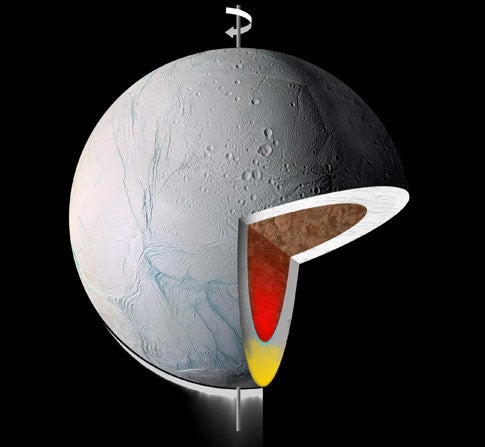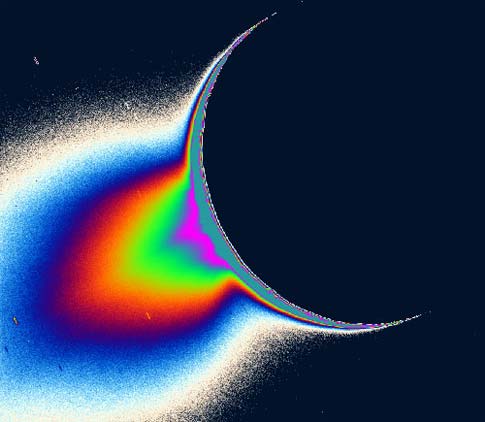Scientists were delighted last year when the Cassini spacecraft found plumes of water venting from Saturn’s moon Enceladus. These “ice geysers” gush from an area at the moon’s south pole that’s 27° F (15° C) warmer than the rest of Enceladus’ surface.
Francis Nimmo at the University of California, Santa Cruz, and Robert Pappalardo, at NASA’s Jet Propulsion Laboratory in Pasadena, California, believe the warm spot’s location is no coincidence. Their research, published in the June 1 issue of Nature, suggests the material that creates the moon’s warm spot also caused Enceladus to roll over until the spot was positioned at the pole.
Scientists believe warm, low-density material rising from the moon’s interior forms the hot spot, but it would be an odd coincidence if this process occurred exactly over the moon’s south pole. “The mystery we set out to explain was how the hot spot could end up at the pole if it didn’t start there,” Nimmo says.
“It’s astounding that Cassini found a region of current geological activity on an icy moon that we would expect to be frigidly cold, especially down at this moon’s equivalent of Antarctica,” Pappalardo says. “We think the moon rolled over to put a deeply seated warm, active area there.”
Planetary scientists call such a rising blob of matter a diapir. Nimmo and Pappalardo aren’t sure whether the diapir lies within the moon’s icy shell or its underlying rock. Either way, as the material heats up, it expands, becomes less dense, and then rises toward the surface. This ascending material could also help explain the hot spot itself and the striking “tiger-stripe” rifts on Enceladus’ surface. Nimmo and Pappalardo calculated that a low-density blob could roll the moon by up to 30° to place the diapir at the pole.
“Any redistribution of mass within the object can cause instability with respect to the axis of rotation,” says Nimmo. “A reorientation will tend to position excess mass at the equator and areas of low density at the poles.”
Mars may illustrate the first case. Its Tharsis bulge, which hosts the solar system’s largest volcano, straddles the planet’s equator. This bulge is an excess of mass, so Mars may have rolled to put Tharsis where we now see it. Enceladus — and, the authors suspect, Uranus’ moon Miranda — rolled to place regions of lower mass at the poles. The scientists await Cassini’s 2008 Enceladus flyby for evidence that will help them test their model.
Where does Enceladus’ internal heat come from? The researchers suggest the cause is the moon’s eccentric orbit around Saturn. “Enceladus gets squeezed and stretched by tidal forces as it orbits Saturn, and that mechanical energy is transformed into heat energy in the moon’s interior,” Nimmo says. Tides created by Enceladus’ changing distance from Saturn — and, possibly, those from sister moon Janus, as well — may supply its internal heat.











